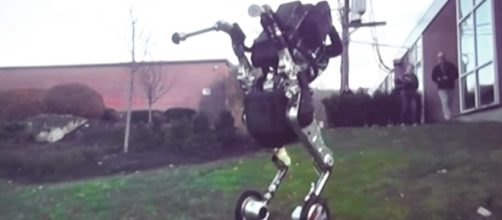Boston Dynamics, a robotics company owned by Google, officially unveiled its latest robot in a YouTube video this past Wednesday. The new robot has been named Handle and stands six feet six inches tall. The Handle looks vaguely humanoid, with articulated arms and legs (that have wheels at the ends) protruding from a high-set torso.
Both the hydraulic and electric actuators for the Handle robot are electronically powered. Handle has fewer actuated joints than other robots built by the same company. This relative simplicity is generally seen as an asset in terms of reliability.
The best of both worlds
In the video’s description on YouTube, the company describes the combination of legs and wheels to be the best of both worlds. The wheels serve to make Handle energy efficient across flat surfaces.
With legs, it is able to manage uneven terrain, so Handle go nearly anywhere. As well, having a vertical leap that is higher than Michael Jordan (48 inches to Jordan’s 46”), the advantage of having legs is apparent.
The wheels, on the other hand, are far more energy energy-efficient than legs could ever be. Boston Dynamics claims that Handle can travel up to 15 miles on a charge, which would simply not be possible if it were to have legs alone. This is far better than Boston Dynamics’ own Atlas bipedal robot, which was smaller as well.
In the video, Handle shows surprising agility and balance for a robot of its size. Handle easily rolls down steps and all sorts of surfaces, including a snow-covered hill outside. It shows off that impressive 48” jump as well by jumping over barriers and onto a table. Handle shows impressive speed and quickness as well in accelerating to its 9 mile-per-hour claimed top speed. The Handle is also capable of carrying heavy loads, lifting up to 100 pounds with one of its hand clips.
Boston Dynamics has posted videos in the past of a number of their other robots, but Handle is the first to make use of the leg/wheel hybrid technology.
Actual adoption
At this point, Handle is still just a research project, and neither Boston Dynamics or parent company Google has stated when we will see Handle operating in real-world settings.
Indeed, we may never actually see a version of Handle make it to the actual workforce. Boston Dynamics has released many exciting videos of its robots doing lots of things, but the gap between making an impressive video to building a robot that is practically usable is a considerable one.
That having been said, the new technology that is showcased in the Handle video shows major strides that are being made in the robotics field. Even if Handle itself never makes it into our workforce, it is a clear indication of the direction that we are headed in.

